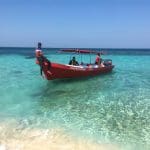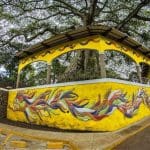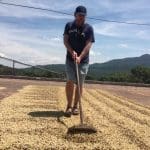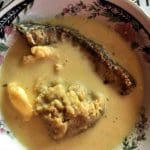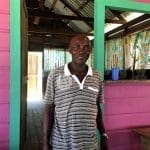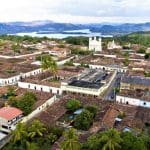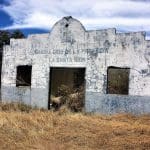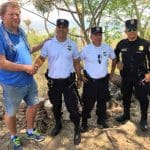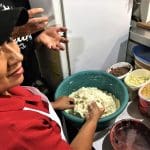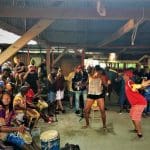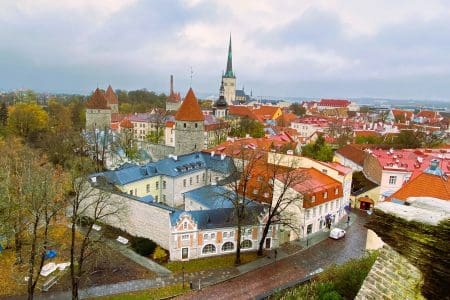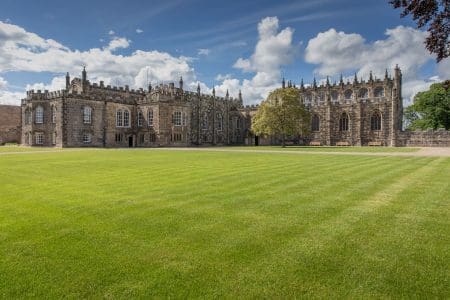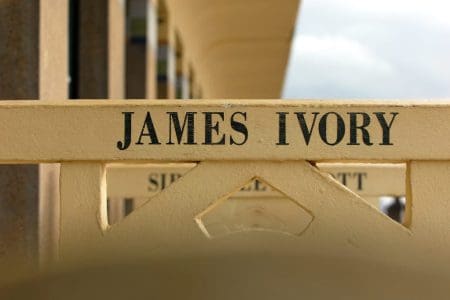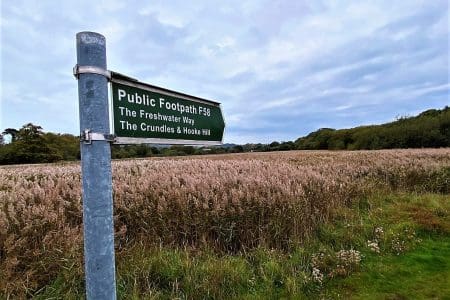Mark Bibby Jackson discovers a wealth of culture and history during his Central America travel through El Salvador and Honduras.
Momentarily disregarding my middle-aged spread, I emerge from the turquoise clear waters like James Bond, at a generous stretch. The fine, warm sands cling to the soles of my feet as I stare towards the flat horizon, just as a pair of pelicans slide onto the mirror calm surface. This is the Caribbean of my dreams come to life.
Chachahuate is one of 13 small cays and two islands in Cayos Cochines, a small archipelago off the coast of Honduras. It is Robinson Crusoe territory, or the land of survivalist TV series, some of which have been filmed here, despite the presence of a research centre and conservation programme, where you can buy cans of beers.
A small community of Garifuna sailed here from the mainland in 1973, and a string of wooden huts dot the tiny stretch of sand. The seafaring Garifuna came to Honduras from Saint Vincent 200 years ago, although their ancestry can be further traced to West Africa.
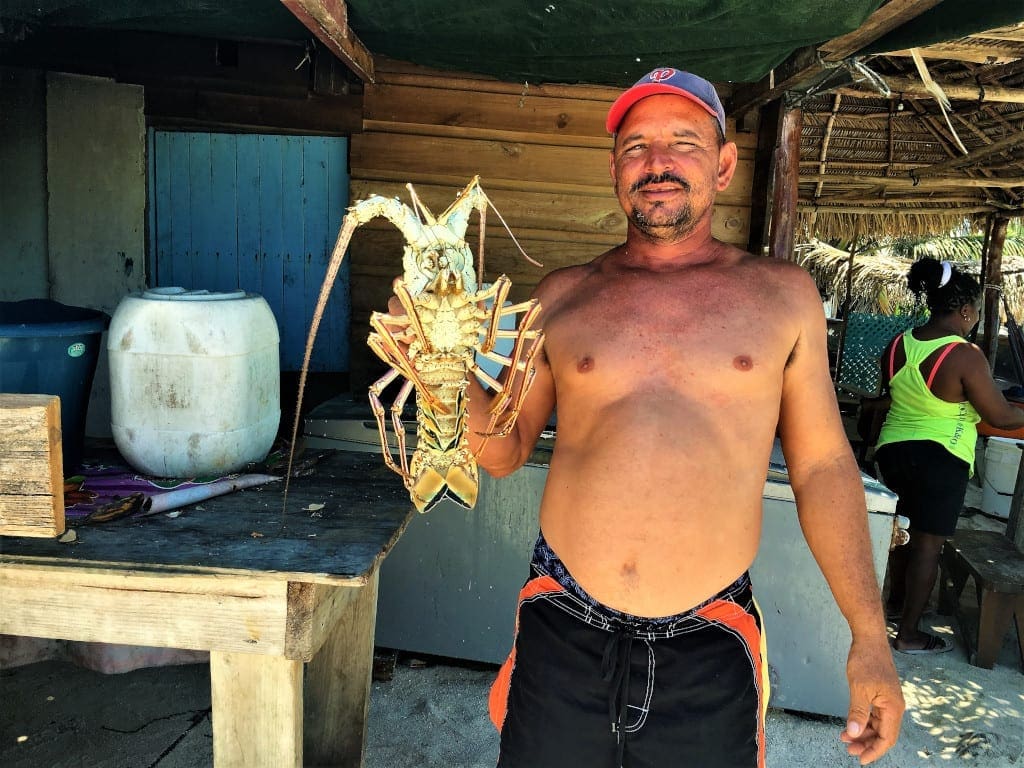
A couple of days earlier, we had flown to the far larger island of Roatan, where we were entertained by some Garifuna music in the town of Punta Gorda. Men and women took it in turn to take to the dance floor, shaking parts of their body that Elvis could only have dreamt of, while their compatriots played the drums, shook maracas and blew conches, providing an irresistible, relentless beat I found quite mesmerising.
Before we had dined at Yurumei restaurant where I had experienced my first Garifuna food – machuca, a conch fish, mashed plantain and coconut milk soup which was excellent. Today on Chachahuate, we are served a fresh snapper caught this morning and served at the community dining hall the 100 or so people share, taking it in turns to feed the steady flow of tourists from the mainland. It tastes amazing.
Climbing a Volcano
All this seems a million miles away from our arrival just over a week ago in San Salvador, the capital of neighbouring El Salvador.
Then, after a restful night in Barcelo Hotel, we had climbed a volcano – as you do on the first full day of your Central American holidays, after a 10-hour flight.
Ilamatepac – literally mountain of the old lady – is one of three mountains that come into view as we depart the capital, San Salvador. It’s also called Santa Ana. The other two are Izalco, or the Lighthouse of the Pacific, and Cerro Verde, with its luscious green national park.
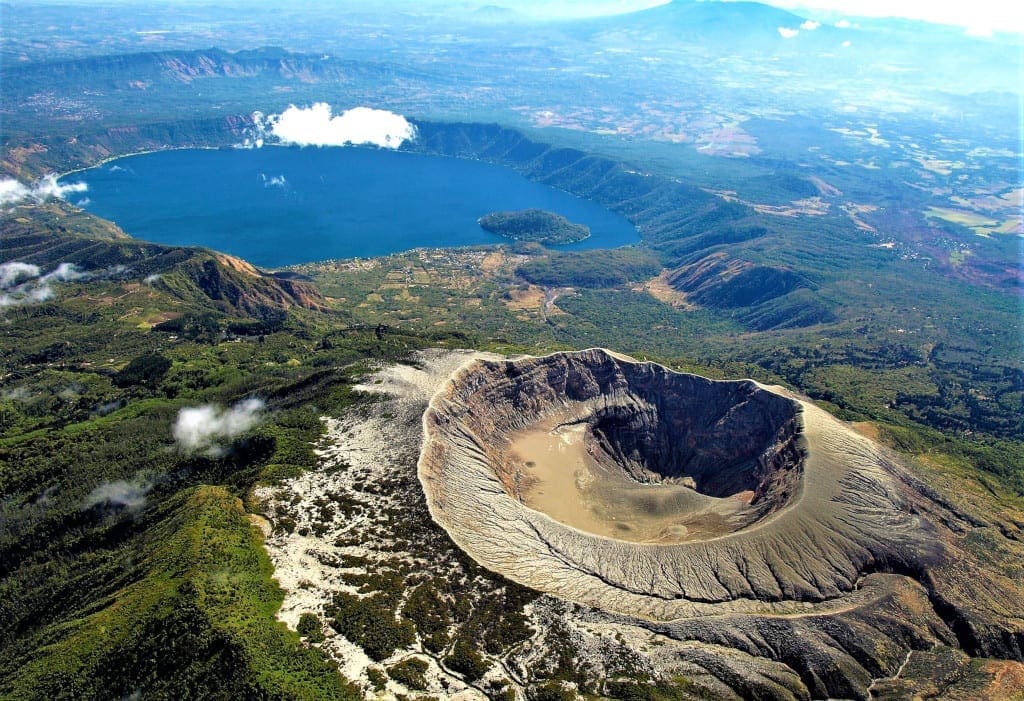
Passing sugar cane plantations, we stop for the first of many selfies requested by our guide Carlos to satisfy the requirements of the Central America Tourism Agency (CATA) which has kindly hosted our motley crew of four travel journalists.
Carlos knows a short-cut which means we do not have to start our climb with the rest of the tourists – mainly Panamanians living in the US returning for a holiday, and students, although there is a German, an Israeli and a Chinese tourist too, as if a preamble to some awful joke.
Instead, we await them by the small community of San Blas, or rather where the community used to stand before the volcano erupted engulfing the small school in ash in 2005. Some 190 schoolkids were evacuated. Both the school and a church remain. You can still see the path the lava flow took chiselled into the side of the volcano.
I began to realise why Salvadorians call this La Octava Maravilla – the Eighth Wonder
Unfortunately, Carlos’ shortcut only bypassed the lower reaches of our climb and we still had to walk for an hour along a path that snaked its way up the volcano. Eventually, the forest gave way to rock and the most spectacular panorama opened up before us, more than rewarding our exertions. At the top, we could look down into the crater and the most glorious green lake.
Feeling virtuous, we descended the volcano and then drove down to Lake Coatepeque, where we had a quick dip in the slightly sulphuric waters before a very late lunch. The sulphur invigorated my skin – reminiscent of my experience in the Dead Sea – and as I ate looking back towards the other two volcanoes, and with a cool breeze coming off the waters, I began to realise why Salvadorians call this La Octava Maravilla – the Eighth Wonder.
Creating Rectangular Pupusas
Santa Ana is also the name for the country’s second largest city and one of the most famous places in El Salvador. Ignoring the appeal of the central square at sunset, where the townsfolk slowly came to life, as if on the set of a Zombie movie, we set off for our restaurant for we had some serious business to do, making pupusas.
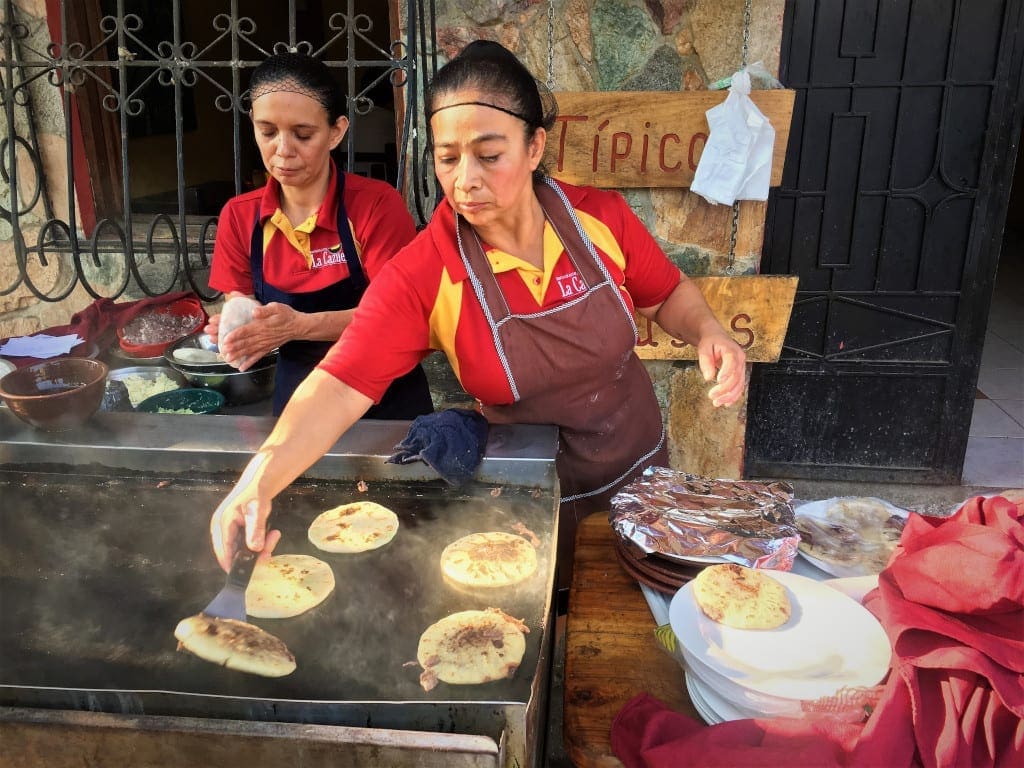
The flatbreads stuffed with a mixture of cheese, chicharrón (or pork rind) and refried beans are the staple of the country. Made with corn bread similar to Venezuelan arepas, pupusas are crammed with the filling before being cooked on a grill. Eaten for both breakfast and dinner – for some reason lunch is bypassed – pupusas are the lifeblood of El Salvador.
Juanita stood in the kitchen of La Pradera ready to provide us with some elementary training in the preparation of the Salvadorian dough balls, which basically consisted in making a ball of the dough, then sticking your thumb in the middle to make a hole sufficient to fill with cheese plus chicharrón, or for the vegetarians refried beans. Finally, you fold the dough to seal the filling before clapping the ball into a round shape. What could be more simple?
Nothing, so long as you remember to twist your hands as you clap, rather than keep them parallel like you are applauding a fine play at the theatre – or, as my colleagues less kindly observed, like a performing seal. So, as the others created round pupusas of varying sizes, I invented the rectangular pupusa, which in all truth tasted pretty much the same as its round cousins.
Coffee Plantations and The Flower Route
The following day, we started with some coffee. A whole estate of it to be precise. Initially introduced by German settlers in the 19th Century, coffee soon became El Salvador’s largest export.
Founded by the Alfaro family in 1930, just outside the town of Atico, El Carmen Estate produces coffee beans for export to brands such as Illy and Starbucks, as well as domestically under its Atico brand, which is about to be exported to Spain.
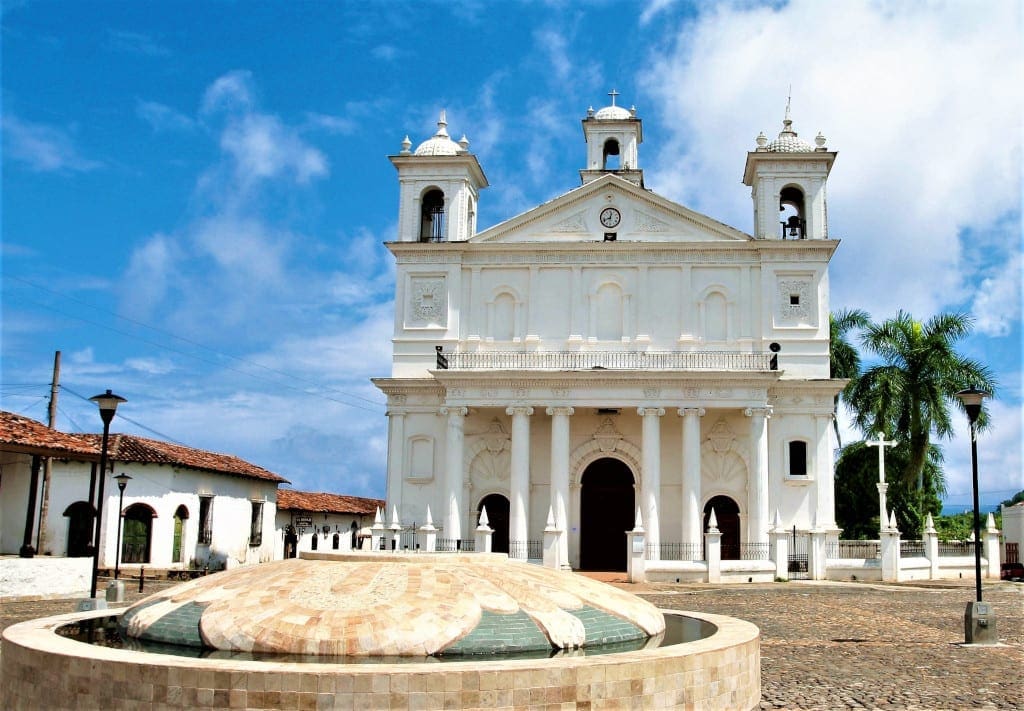
There is something vaguely sadistic about being led around a coffee estate in the morning, especially as the tasting comes at the conclusion of the trip after visiting the aromatic roasting house. Still, the experience of being shown the whole coffee-making process – apart from picking the red cherries – was interesting, especially as we took it in turns to rake the beans laid out to dry.
Atico is part of La Ruta de los Flores (The Flower Route), so named because of the white flowers that dominate the area when the coffee plants are in bloom.
Unfortunately, the relationship between coffee and El Salvador has not always been harmonious, as becomes apparent when we visit the town of Nahuizalco. It was here in 1932 that up to 30,000 indigenous Salvadorians were mowed down by soldiers, under the order of the dictator General Maximilian Hernandez Martinez. At the time, some 5% of the country was devoted to coffee plantations, but after the golden years of 1926-30, the price of coffee spiralled, influenced by the recessions in the US and Europe. Martinez gave the orders for the land to be usurped, and as the locals resisted, they were mowed down by the soldiers.
A small museum commemorates the Massacre of 32, for which there has been no official apology. Ironically, the general’s efforts were counter-productive as with nobody left to work the fields, coffee production fell into further decline.
She went through the painstaking process of sampling moonshine from 25 stills before settling upon the perfect chaparro
Nahuizalco is also noted for the colourful murals which dominate the town, as is Ataco, which is a pleasant cobble-stoned town, where you could easily spend a night or two as you explore the coffee plantations and surrounding countryside. Set at an altitude of some 1,800 metres, the weather is much cooler than at sea level, especially at night.
Waterfalls and Chaparro
Our final day in El Salvador started with a treat. Carlos had arranged for us to try some of the local moonshine – or chaparro. In preparation for the sugar cane spirit, we had some fresh pupusas for breakfast at La Cazuela restaurant; they were the best we tasted on our trip, even surpassing my rectangular offering.
Chaparro used to be distilled in stills in the mountains far from the prying eyes of soldiers. It is here that the guerrillas used to hide out – some tour groups now visit their tunnels. This was until Claudia Caceres came along. The entrepreneurial woman decided the spirit should have its own geographical recognition, much like champagne in France. So, she went through the painstaking process of sampling moonshine from 25 stills before settling upon the perfect chaparro.
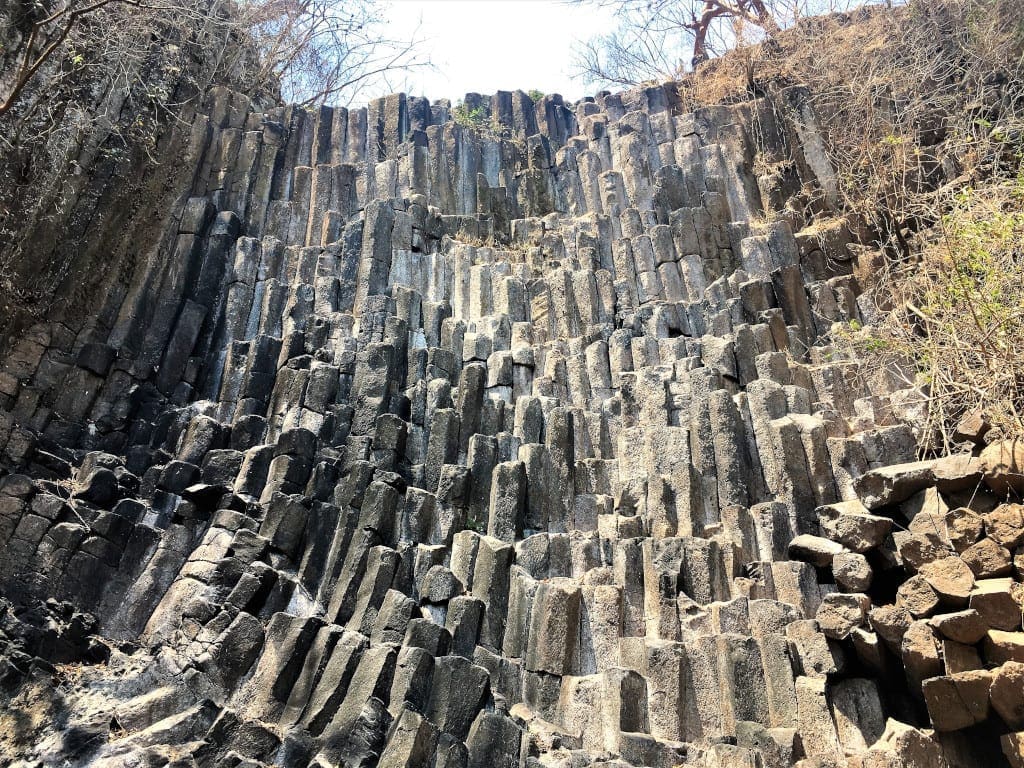
This, she now offers us after explaining the distilling process at her small still. Now, I have tried a lot of local hooch in my time – normally it brings water to my eyes. One particular occasion in provincial Vietnam for a colleague’s engagement that involved memory loss, unscheduled visits to the toilet and a flagrant disregard for footwear, stands out. However, Claudia’s chaparro – under the Flor de Fuego label – proved remarkably smooth. No extra hairs appeared on my chest and my feet remained shod.
A short drive along La Ruta de Azul – the Blue route, named after the local indigo – took us to Suchitoto, perhaps the prettiest of El Salvador’s ‘tourist’ towns.
Here, we had an appointment with the tourist police. Normally, I try to avoid the local constabulary when on vacation, especially those carrying firearms. However, in El Salvador, the tourist police, in addition to ensuring your safety, multitask as unofficial guides.
So we discovered as Francisco Rodriguez and his cohort led us to Los Cercios waterfalls just outside the town. According to our guardians, legend has it the rocks, which resemble a giant game of jenga, were formed when a man refused to pay a craftsman for fabric he had created. The honest artisan was so enraged that he cursed his client and turned his rolls of textiles into rocks and the man himself into a goldfish that still resides in a small pool at the bottom of the falls.
To secure the tourist police’s services all you have to do is knock on the police station door and arrange a time to visit the waterfalls. They might even let you play with their horses out the back of the station.
All that was left for us, was to dine at Suchitoto’s idyllic Casa 1800 with the most amazing views down to the valley below, as locals took it in turn to pose for their photos to be taken, before we returned to Hotel Barcelo, the first leg of our Central America travel adventure now complete.
Is El Salvador Safe?
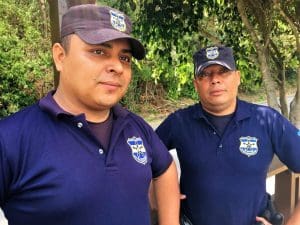
Central America travel is not for everyone. However, if you take the standard precautions then you should find your trip both safe and enjoyable, especially as the tourist police are there to ensure your safety. However, it is best to keep abreast of the latest travel advice; this might affect your Central America travel insurance.
Flights to El Salvador and Honduras
We flew with Iberia from London Heathrow to San Salvador via Madrid and Guatemala City, returning the same way without a pit-stop in Guatemala City. To book your flight click on the link below.
Hotels on Your Central America Travel
For hotels in Honduras and El Salvador, as well as flights, try our hotel comparison engine by entering your dates below – we search hundreds of websites so you can find the best deals.
Click to search for hotels with AgodaCentral America Travel Photo Gallery
More information on Central America Travel
The best place to check in for advice and tips on Central America travel is the Central America Tourism Agency (CATA). Photos by Mark Bibby Jackson or courtesy of CATA.
